|
|

Joined:
October 2005
Posts: 4075
Location: Utah | This experiment was both a success and a failure. My Adamas 2080 is slightly mellow in tone, and I thought a bone saddle would improve it. Indeed it did make an improvement in tone acoustically. The difference is subtle, with more clarity and a bit more crispness. But, plugged in with the new saddle it sounds thin. With the factory piezo saddle it sounds amazing plugged in, better than any other O or A I've heard. So my modification improved the acoustic tone a small amount, but killed the plugged in sound.
I think the lesson here is that the plastic saddle is a compromise and cost savings, and is quite adequate. But it could be improved upon for pure acoustic tone. The OPP piezo elements are superior to the aftermarket think piezo pickup I installed.
Here's an old Ovation Original Patented Pickup. The two small plastic end caps have been removed.

Here is the side view.
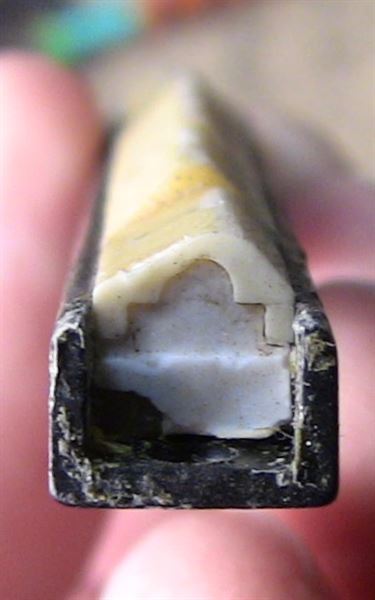
The plastic (Delrin) saddle pulls up easily, revealing RTV underneath which encapsulates the piezo elements and the wiring. RTV is just like bathtub caulk, soft and rubbery.
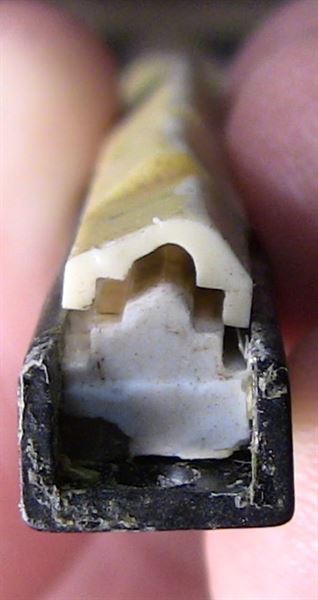
In this photo I've picked out the RTV from around the first piezo element. A wire runs along the top of the crystals, while another wire runs along the bottom for electrical connection. The piezo crystals are chunky and take up a lot of space in the assembly.
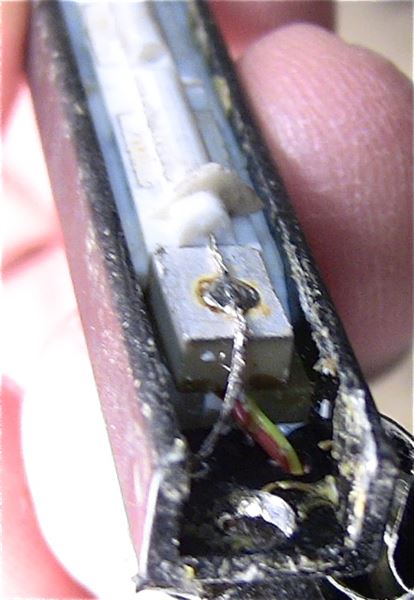
|
|
| |
|

Joined:
October 2005
Posts: 4075
Location: Utah | I found a slim 1/8" wide piezo pickup from Artec to use for this project. I had hoped to find a wider pickup but had no luck.
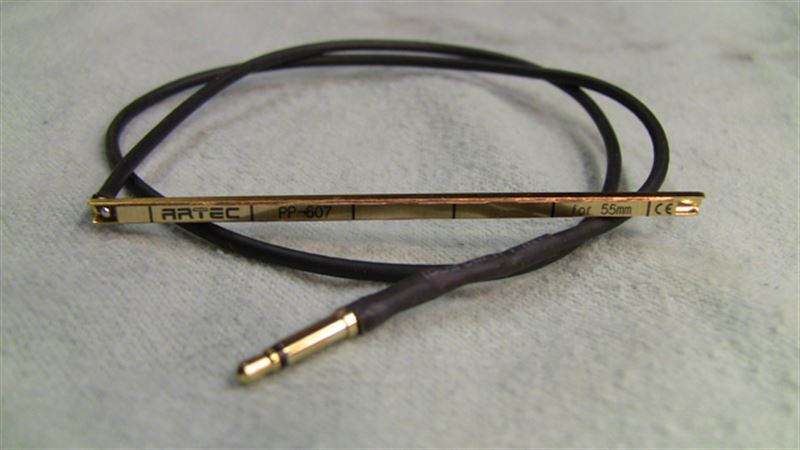
So I made an ebony carrier for the thin pickup and used a 1/8" bone saddle. Our ancient piano of over 100 yrs old died a few years ago and we kept all the keys (including all the ivory). The black keys are indeed made out of ebony though they are painted over with a gloss black finish.
Here is one of the black keys.

The ebony was cut off. Interestingly, one of the keys was not made out of ebony. Presumably a repaired key. The ebony is visible in the right hand piece.
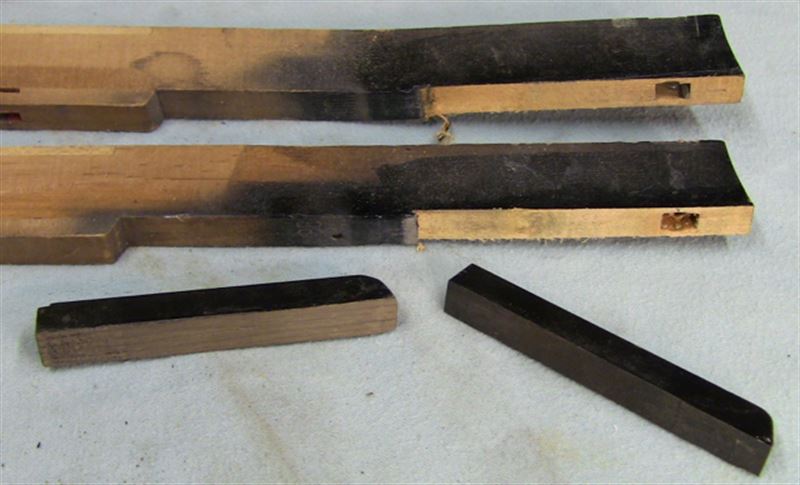
I machined a piece to the same dimensions as the original Ovation pickup, though a bit taller. By making it taller, no shims are necessary underneath it. A 1/8" wide slot was cut down the center of the ebony piece, leaving a small amount of wood in the bottom of the slot. The final ebony piece is in the middle. The original saddle is on the bottom, with the remainder of the original assembly above it for comparison.
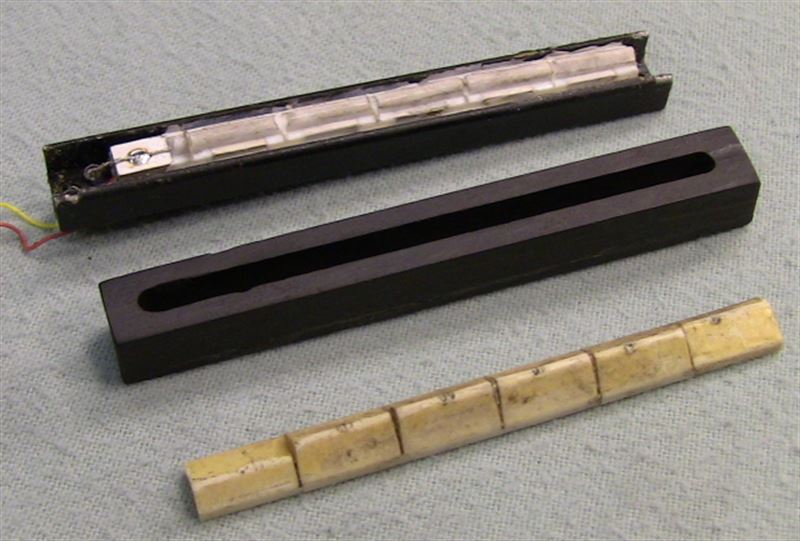
The floor of the slot is .030" thick. Enough to provide some strength but thin enough to allow a deep slot to hold the new bone saddle securely.
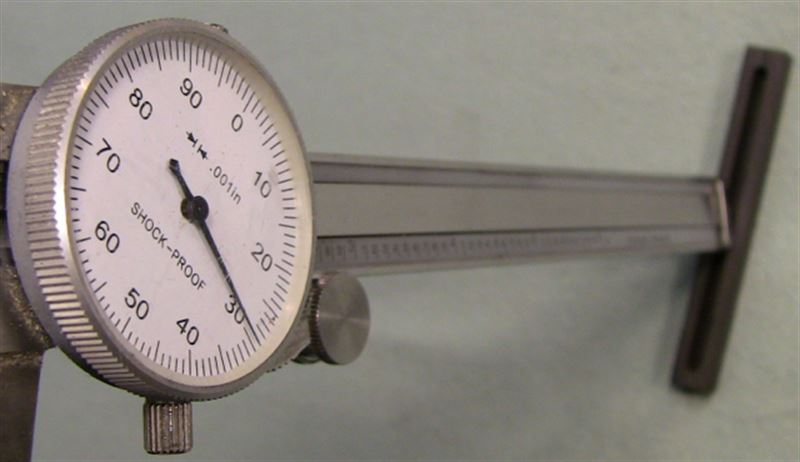 |
|
| |
|

Joined:
October 2005
Posts: 4075
Location: Utah | The Artec pickup fits easily in the ebony carrier.
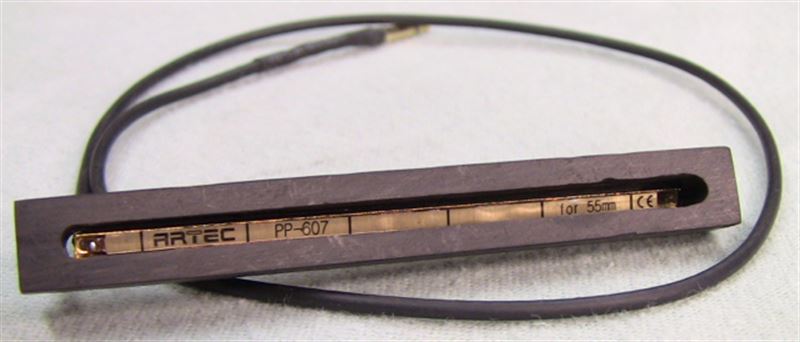
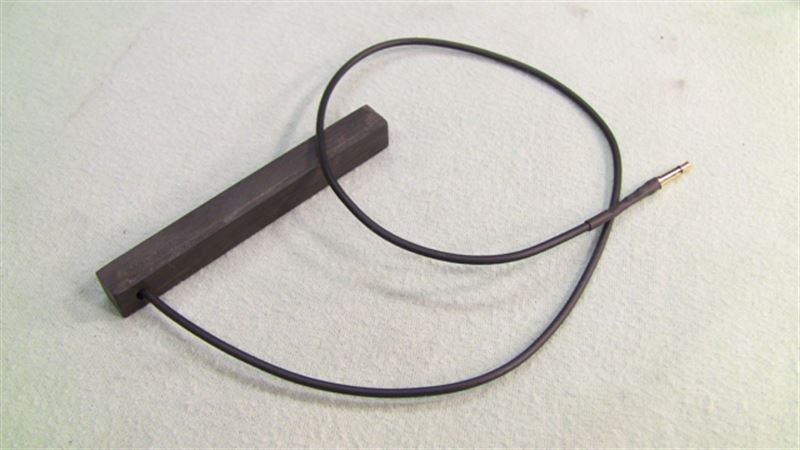
The unfinished bone saddle fits into the carrier on top of the piezo. The saddle has been cut to length and radiused.
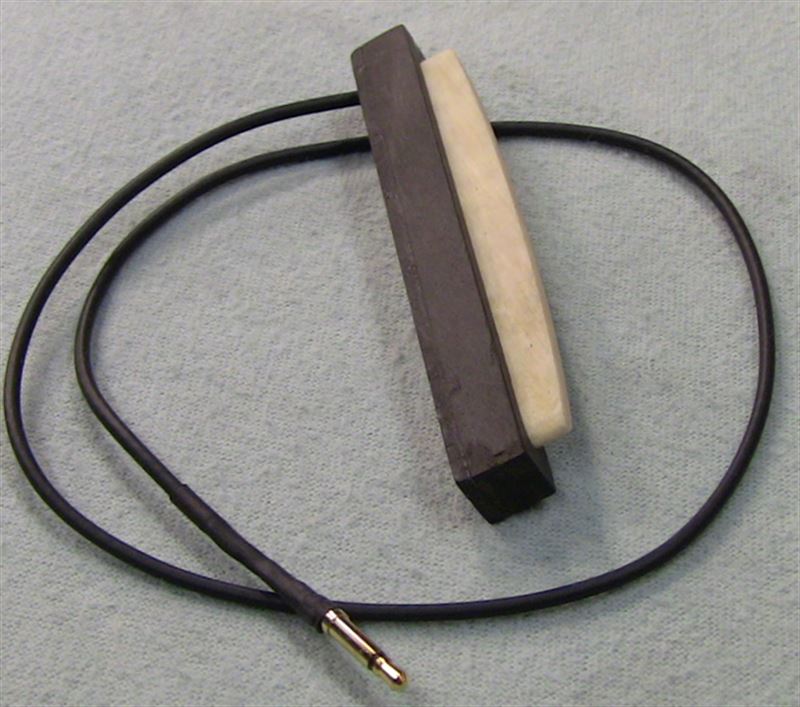
Here is the finished product installed in the guitar. The saddle has been fully compensated and the height adjusted for string action the way I like it.
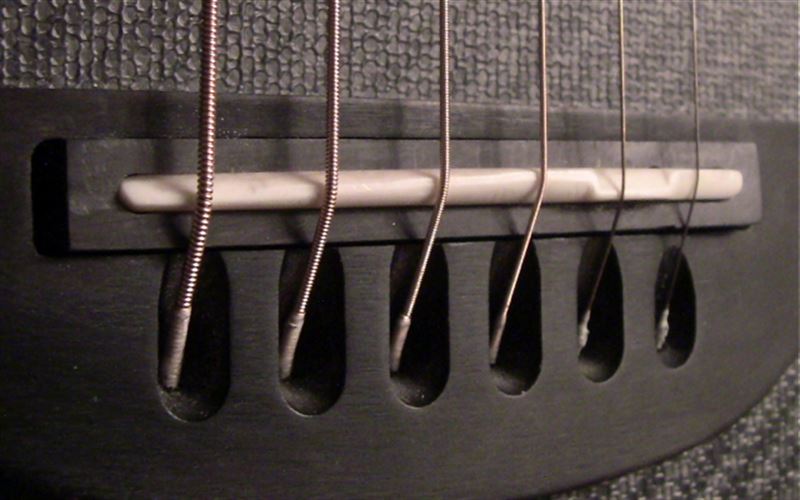 |
|
| |
|

Joined:
October 2005
Posts: 4075
Location: Utah | So this was not a full success and I'll put the original pickup assembly back in. But I'll cut one solid ebony shim to replace the two plastic shims under the original saddle assembly. One thing I would do differently if I tried this again is to make the ebony carrier longer to fully fill the slot in the bridge. If I can find a wider piezo pickup I will try this experiment again.
The next experiment is to machine a bone saddle to replace just the Delrin plastic saddle in an Ovation pickup. Removing the RTV caulk is tricky, and it is easy to damage the piezo crystals. Other than that I think it will just be a matter of paying attention to detail when machining the bone saddle to fit properly. |
|
| |
|
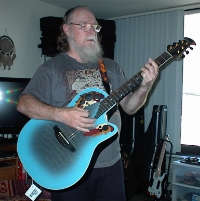
Joined:
September 2006
Posts: 10777
Location: Keepin' It Weird in Portland, OR | Very Educational. 
|
|
| |
|
Joined:
November 2002
Posts: 3651
Location: Pacific Northwest Inland Empire | Recycling pianos.........maybe, it IS a "just Universe". |
|
| |
|
Joined:
March 2005
Posts: 12759
Location: Boise, Idaho | Any theories for the lack of piezo response to the bone saddle? |
|
| |
|
Joined:
December 2003
Posts: 855
Location: Canada | Interesting. Other than the difference in piezo elements, from your description it sounds like the bone saddle was in contact with the artec, while the original assembly has RTV between piezo and plastic saddle. So I wonder what's the role of the RTV in this and if this aids in transmission of vibration from saddle to piezo rather than hinders it? |
|
| |
|

Joined:
August 2007
Posts: 1008
Location: Tuscany, Italy | Bravissimo !! very good and effective solution. I like it and I will replicate it on one of my guitar in case of need...... |
|
| |
|

Joined:
October 2005
Posts: 4075
Location: Utah | Mark in Boise - 2014-11-13 9:47 AM
Any theories for the lack of piezo response to the bone saddle?
The piezo is lacking in the low frequencies. The E and A strings don't sound full through the piezo. It is also quackier than the Ovation pickup. I am guessing but I think it is a difference in size of piezo crystals. The Ovation piezo crystals are at least twice as thick and probably 4x the surface area compared to the Artec.
Even with changing the EQ I can't get this Artec pickup to sound nearly as full as the Ovation OPP.
Artec makes a different unit which has the same dimensions but they describe as warmer. If I can find one of those I will give it a try. |
|
| |
|

Joined:
October 2005
Posts: 4075
Location: Utah | merlin666 - 2014-11-13 10:33 AM
Interesting. Other than the difference in piezo elements, from your description it sounds like the bone saddle was in contact with the artec, while the original assembly has RTV between piezo and plastic saddle. So I wonder what's the role of the RTV in this and if this aids in transmission of vibration from saddle to piezo rather than hinders it?
The edge of the Delrin saddle sits on the edge of the piezos. There isn't much contact area but it is free of RTV. The RTV covers all the wiring above and below the piezos. It provides a moisture barrier to help stop corrosion, which would be my guess why it is in there.
I suspect it also absorbs some sound energy from the saddle. Honestly though I am surprised that the OPP sounds so good acoustically given the construction. The bone is an improvement but not a huge one. |
|
| |
|
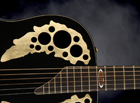
Joined:
October 2012
Posts: 1091
Location: Yokohama, Japan | Thanks for the informative and interesting post FlySig. Really creative attempt at testing alternative piezos for tone. Just over a year ago, the original thinline piezo on my 1861 stopped working completely. At that time, with OMA's help, I tried the Artec PP-607, but there was another brand called the TM SAP 55mm piezo. I bought both to try them out, and IMHO, while neither sounded as good as the original, the TM SAP 55mm sounded fuller than the Artec, and it's the one that stayed in my 1861. However, it is no where to be found on eBay anymore. I had a local luthier make a TUSQ saddle for my 1861, and it really made a big difference in the sound. On a separate note, when I had my '74 Yamaha FG160 restored, the nut and bridge saddle were changed to TUSQ. That really added quite a bit of depth to the Yamaha's voice. I've really come to like TUSQ, but I suspect there must be a difference between TUSQ and bone? Any thoughts?
Edited by arumako 2014-11-14 5:21 AM
|
|
| |
|
Joined:
December 2004
Posts: 577
Location: Denmark | I have one guitar with the Ovation High Output PU (thinline like) and one with the original (wide) pickup. The original is much fuller sounding. Regarding the bass response I think that there should be cut free in the slot and saddle to ensure that the full string pressure goes directly on to the piezo element and not on to the solder point. Piezos depend on being in a state of compression. |
|
| |
|
Joined:
April 2010
Posts: 823
Location: sitting at my computer | Interesting thread.  FlySig - The next experiment is to machine a bone saddle to replace just the Delrin plastic saddle in an Ovation pickup. Removing the RTV caulk is tricky, and it is easy to damage the piezo crystals. Other than that I think it will just be a matter of paying attention to detail when machining the bone saddle to fit properly.
Looking forward to reading how the "next experiment" works out. |
|
| |
|
Joined:
December 2004
Posts: 577
Location: Denmark | Many good tips here: http://www.fishman.com/files/advanced_undersaddle_pickup_installati... - They also pay a fair bit of attention to the mechanical evenness of pressure on the piezoelectric element by individual strings. One thing to consider is that the bone/ebony assembly is very stiff compared to the original pickup - which actually is quite flexible - so it needs to be a perfect fit in the guitar saddle slot besides being fairly well matched between bone and ebony part.
If I were you before discarding the pickup assembly I would recheck the perfect fit of the ebony part in the guitar - maybe even test fine shimming. If that doesn't do it I would weaken the bone nut making it more flexible by cutting some narrow but deep grooves in it to see if it has an influence before discarding the parts.
Edited by tpa 2014-11-14 3:56 PM
|
|
| |
|

Joined:
October 2005
Posts: 4075
Location: Utah | TPA, thanks for that reference which I will read. I had considered making 6 individual saddle pieces to create independence between the strings, but that was too much work for the first pass. The Ovation OPP saddle actually has slices between each string section with a small connecting segment to keep them from falling apart. |
|
| |
|
Joined:
December 2004
Posts: 577
Location: Denmark | Something like this:

will provide flexibility and something to assure that things will not fall apart when strings are changed.
Edited by tpa 2014-11-15 6:46 AM
|
|
| |
|

Joined:
June 2012
Posts: 2339
Location: Pueblo West, CO | SOBeach - 2014-11-14 10:58 AM Interesting thread.  I agree! I love looking at the DUBOBs of these guitars. (Dark Underbelly of the Beast) |
|
| |
|

Joined:
October 2005
Posts: 4075
Location: Utah | I disassembled the new saddle assy and really looked at it carefully. All of the surfaces are square and straight. The problem does seem to be the Arctec pickup. I put the original OPP back in and there is just no comparison, it sounds so much better plugged in. The Fishman piezo strip would fit but at $70 it is a very expensive experiment. |
|
| |
|

Joined:
October 2012
Posts: 1091
Location: Yokohama, Japan | I love your creative approach to testing the piezo pick-ups FlySig. Thanks for sharing! I've got an extra TM SAP 55mm piezo (that I posted about in this thread) just sitting around. It seems to have been put together better than the Artec (although it's a bit thinner physically), and IMO they sound a bit better (fuller) too. I'd be interested in hearing how it sounds (or "if" it sounds at all in your Adamas). I don't want to be a PITA, but if you're interested, and still feel like continuing the experiment PM me, I'll send it to you no charge. Thanks! |
|
| |
|
Joined:
December 2004
Posts: 577
Location: Denmark | I was wondering about how the compensations for the saddle are laid out and found this magnificent ressource: http://www.liutaiomottola.com - Specifically there is this:
http://www.liutaiomottola.com/formulae/compensation.htm tool for calculation compensation.
Or here: http://www.luth.org they offer a spreadsheet for the same task: http://www.luth.org/images/web_extras/al104/compensation%20calculat...
Edited by tpa 2014-11-25 3:02 PM
|
|
| |
|

Joined:
October 2005
Posts: 4075
Location: Utah | arumako, I've been looking at the TM and it looks like it may be better than the Artec unit. There's one available on eBay which I'll grab and try out. Thanks for the offer to send one. |
|
| |
|

Joined:
June 2012
Posts: 2339
Location: Pueblo West, CO |
Nice find. Thanks!
Edited by DanSavage 2014-11-25 4:13 PM
|
|
| |
|

Joined:
October 2005
Posts: 4075
Location: Utah | tpa, those are some interesting links with a lot of info to browse through. An interesting read on compensation and intonation can be found at www.setitupbetter.com .
My method was not terribly scientific. I copied the B string location from commercial a compensated saddle, placed the high E string at the forward edge of the saddle which is very close to where it is on the Ovation OPP, and then slanted the G D A E strings from the front to the back of the saddle. I figured Ovation placed their saddles in a reasonably accurate location, so I didn't bother getting too crazy with it.
Edited by FlySig 2014-11-25 4:19 PM
|
|
| |
|

Joined:
October 2012
Posts: 1091
Location: Yokohama, Japan | Thanks for the cool links tpa! Another treasure chest of valuable information!
Can't wait to hear your thoughts on the TM SAP piezo, FlySig. I hadn't seen them on e-Bay for a while, but I guess they are back. The Fishman at $70 is a bit much for an experiment, but at 15 bucks the TM SAP was well worth it for my 1861. I wonder how it will sound in an Adamas?
Edited by arumako 2014-11-26 6:31 AM
|
|
| |
|
Joined:
March 2013
Posts: 359
Location: undisclosed | Did you try a different preamp? The Ovation unit is optimized for the factory pickup.
The stock pickup saddle "floating" on the rtv seems like it would vibrate more freely creating more energy in the piezo elements but also transfer less energy to the body.
|
|
| |
|

Joined:
October 2005
Posts: 4075
Location: Utah | No, just the Ovation preamp.
The factory plastic saddle has nearly independent individual string saddles, connected by a very small section. Idk if this has some effect on the tone of the assembly or not. It may allow more energy to transmit to each individual piezo element with less bleed over onto other adjacent piezo crystals. One of my planned experiments is to make individual bone saddle elements for each string. First I need several OPP saddle/pickup assemblies and then start machining bone saddles. |
|
| |
|
Joined:
March 2013
Posts: 359
Location: undisclosed |
Reducing the "cross talk" may be the intention. I play a Zeta Violin and in many ways the pickup is similar to an Ovation. In the violin's case the reduced cross talk/bleed through is used to minimize tracking glitches when playing with a midi converter. This might be worth a try on a Ovation instead of a hex pickup but would need a single connection to each element. |
|
| |
 Bone saddle for a piezo pickup
Bone saddle for a piezo pickup Bone saddle for a piezo pickup
Bone saddle for a piezo pickup